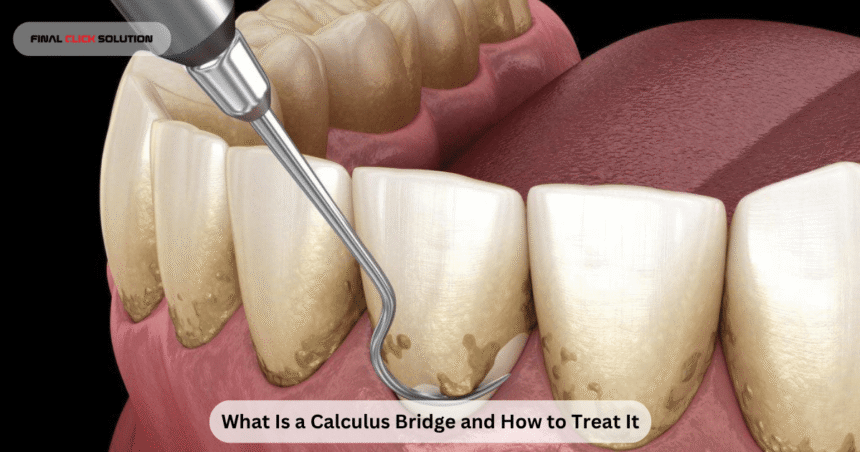Oral health plays a crucial role in maintaining overall well-being. However, one of the most overlooked dental conditions is the calculus bridge—a stubborn buildup of hardened plaque that can lead to serious gum and tooth problems if not treated properly. In this article, we’ll take a detailed look at what a calculus bridge is, how it forms, its impact on dental health, and the best ways to prevent and treat it.
What Is a Calculus Bridge?
A calculus bridge refers to a thick, hard layer of tartar (also known as calculus) that forms along and between teeth. It often creates a “bridge-like” structure connecting two or more teeth. The term “calculus” in dentistry refers to hardened dental plaque — a sticky film of bacteria that coats your teeth after eating or drinking.
When plaque isn’t removed through regular brushing and flossing, it hardens into tartar within 24 to 72 hours. Over time, this tartar can expand and merge between teeth, forming what dentists call a calculus bridge.
This hardened material cannot be removed by normal brushing at home and requires professional dental cleaning. If left untreated, it can cause gum inflammation, gum disease, and even tooth loss.
How Does a Calculus Bridge Form?
The formation of a calculus bridge is a gradual process that begins with plaque accumulation. Here’s how it happens step-by-step:
- Plaque Formation:
After eating, especially foods rich in sugars and starches, bacteria in your mouth feed on the leftover particles. These bacteria produce acids that mix with food debris and saliva, forming a sticky layer called plaque. - Plaque Hardening into Tartar:
If plaque isn’t removed through proper oral hygiene, it starts to harden within a few days. This hardened material is known as tartar or dental calculus. - Tartar Expansion:
Over time, tartar builds up layer by layer. When it forms heavily between teeth or near the gum line, it can create a bridge-like structure connecting multiple teeth — thus the term calculus bridge. - Gum Irritation and Inflammation:
The presence of tartar irritates the gums, leading to redness, swelling, and bleeding — early signs of gingivitis, the first stage of gum disease. - Advanced Gum Disease (Periodontitis):
If the calculus bridge isn’t removed, bacteria can move deeper into the gums and bone, causing periodontitis, which can ultimately result in loose teeth or tooth loss.
What Does a Calculus Bridge Look Like?
A calculus bridge is often visible as a yellow, brown, or dark gray deposit between teeth or along the gum line. In severe cases, it may look like a solid band of stone-like material covering multiple teeth.
Some patients describe it as a “cement-like” coating or a rough layer that can’t be brushed away. The gums around the calculus bridge may appear swollen, tender, or bleed when brushing or flossing.
Symptoms of a Calculus Bridge
In the early stages, you may not feel pain or notice obvious signs. However, as the buildup increases, you might experience the following symptoms:
- Persistent bad breath (halitosis)
- Yellow or brown deposits on teeth
- Swollen, bleeding, or tender gums
- A rough or uneven surface when you run your tongue across your teeth
- Receding gums, exposing tooth roots
- Loose teeth or changes in how your teeth fit together
- Sensitivity to hot or cold foods
If you experience several of these symptoms, it’s crucial to visit a dentist immediately. Early detection can help prevent long-term damage.
Health Risks Associated with a Calculus Bridge
Ignoring a calculus bridge can lead to several oral and overall health issues, including:
1. Gum Disease
The most common risk associated with tartar buildup is gum disease. The bacteria within the calculus irritate gum tissue, leading to inflammation and infection. Left untreated, this can progress from gingivitis to periodontitis, a severe form of gum disease that destroys bone and tissue.
2. Tooth Decay
The bacteria in tartar release acids that erode tooth enamel, causing cavities. Because tartar holds bacteria close to the gums and teeth, it increases the risk of decay.
3. Tooth Loss
In advanced cases of periodontitis, the supporting structures of your teeth—including the gums and jawbone—begin to deteriorate. This can cause teeth to loosen and eventually fall out.
4. Systemic Health Problems
Research has shown a strong link between gum disease and systemic conditions such as heart disease, diabetes, and respiratory infections. Bacteria from infected gums can enter the bloodstream, causing inflammation in other parts of the body.
How Dentists Diagnose a Calculus Bridge
Dentists can usually identify a calculus bridge during a routine dental examination. They may:
- Visually inspect your teeth and gums for buildup.
- Use dental instruments to check for rough or hard areas along the gum line.
- Take dental X-rays to evaluate the extent of the tartar below the gum surface.
A professional diagnosis helps determine the severity of buildup and the right treatment plan.
Treatment Options for a Calculus Bridge
Unfortunately, once tartar forms, you cannot remove it with regular brushing or flossing. Professional dental care is the only way to eliminate a calculus bridge effectively.
Here are the most common treatment options:
1. Professional Dental Cleaning (Scaling)
The dentist or hygienist uses special tools (scalers and ultrasonic instruments) to gently remove tartar from above and below the gum line. This process is known as scaling. It’s the most effective method for eliminating calculus bridges and restoring gum health.
2. Root Planing
In cases of gum disease, the dentist may perform root planing, which involves smoothing the tooth roots to help gums reattach to the teeth. This reduces the space for bacteria to accumulate and promotes healing.
3. Laser Treatment
Modern dental clinics may use laser technology to remove tartar and bacteria with precision. Laser treatment can reduce discomfort and improve healing compared to traditional methods.
4. Antibiotic Therapy
If there’s a bacterial infection, dentists might prescribe antibiotic gels or oral medication to control the infection and promote gum recovery.
5. Surgical Intervention (Advanced Cases)
In severe cases, such as deep periodontal pockets or extensive bone loss, surgical procedures like flap surgery or bone grafting may be necessary to restore oral health.
Can You Remove a Calculus Bridge at Home?
The short answer is no. Once plaque hardens into calculus, it can’t be removed with toothpaste or brushing alone. Trying to scrape it off using sharp objects can damage your enamel and gums, leading to injury or infection.
However, you can prevent future buildup through good oral hygiene practices, which we’ll discuss next.
How to Prevent a Calculus Bridge
Prevention is always better than cure when it comes to dental health. Here are proven ways to prevent plaque and calculus formation:
1. Brush Twice Daily
Use a soft-bristled toothbrush and fluoride toothpaste to brush at least twice a day. Make sure to clean all surfaces of your teeth, especially near the gum line.
2. Floss Daily
Flossing helps remove food particles and plaque between teeth—areas your toothbrush can’t reach. Consistent flossing reduces the risk of plaque hardening into tartar.
3. Use an Antiseptic Mouthwash
Mouthwash helps kill bacteria that cause plaque and gum inflammation. Choose an alcohol-free antibacterial mouthwash for best results.
4. Maintain Regular Dental Checkups
Visit your dentist every six months for professional cleaning and checkups. Routine dental visits ensure that any tartar buildup is detected and removed early.
5. Eat a Balanced Diet
Limit sugary and starchy foods, which feed oral bacteria. Instead, eat more fruits, vegetables, and foods rich in calcium and vitamins that strengthen teeth and gums.
6. Avoid Tobacco Products
Smoking and chewing tobacco increase tartar buildup and slow down gum healing. Quitting these habits can drastically improve your oral health.
7. Drink Plenty of Water
Water helps rinse away food debris and bacteria, reducing plaque buildup. Drinking fluoridated water also strengthens tooth enamel.
The Link Between Oral Hygiene and Overall Health
Your mouth is the gateway to your body’s health. Neglecting dental hygiene can trigger or worsen various systemic conditions. For example:
- Heart disease: Inflammation from gum disease can increase cardiovascular risk.
- Diabetes: Gum infections make it harder to control blood sugar levels.
- Respiratory issues: Inhaling oral bacteria can cause lung infections or worsen existing conditions.
By preventing a calculus bridge, you’re not only protecting your smile but also promoting better overall health.
Myths and Misconceptions About Calculus Bridges
Let’s clear up some common myths:
- Myth 1: “Brushing harder removes tartar.”
Fact: Brushing harder can damage enamel and gums but won’t remove tartar. - Myth 2: “Mouthwash alone can clean tartar.”
Fact: Mouthwash can help control bacteria but cannot dissolve hardened calculus. - Myth 3: “Calculus bridges only affect older people.”
Fact: Anyone with poor oral hygiene—regardless of age—can develop tartar buildup.
When to See a Dentist
You should schedule a dental visit immediately if you notice any of the following:
- Hard deposits that don’t go away with brushing
- Bleeding or swollen gums
- Persistent bad breath
- Receding gums or loose teeth
Early treatment can prevent irreversible damage and costly dental procedures later.
Final Thoughts
A calculus bridge may seem like a minor dental issue, but it’s a warning sign of deeper oral health problems. Regular dental hygiene, professional cleanings, and awareness can prevent this stubborn buildup and its serious complications.
Taking care of your teeth is more than just maintaining a bright smile — it’s an investment in your long-term health.







